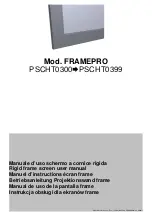
Message
requirement
Description
The acknowledgment is returned after the message has been received and fully executed
by Crimson (such as in the case of a source switch it is not sent until the switch is
complete). If the message cannot be executed for some reason (such as invalid
parameters, time-out, and so on) a NAK is returned instead (not-acknowledge).
Requesting an acknowledgment serves no purpose when included in a request message,
as the acknowledgment is redundant to the actual reply from Crimson. However, if
requested, the dollar sign ($) acknowledgment from Crimson follows the reply.
There are two types of acknowledgments:
• Simple Acknowledgments—Insert a dollar sign ($) character just after the start code
bracket. This only returns a $. This only returns a dollar sign ($) on success, or a
caret (^) on failure (NAK).
• Full Acknowledgments—Insert a hash (#) character just after the start code bracket.
This returns the message sent, as a reply.
This is a quick way to confirm success with set messages and is useful with long distance
communication links or where the projectors and/or images are not visible from the
controller. Acknowledgments can also be a type of flow control.
Checksums
For maximum message integrity, add a checksum character ampersand (&) just after the
start code bracket. You must also include the correct checksum total (0-255) just before
the end code bracket. Make sure to add a space before the calculated checksum to
separate it from the last data parameter:
The checksum is the low byte of the sum of the ASCII values of all characters between the
start bracket and the beginning of the checksum, but not including either. It does include
the space in front of the checksum.
Calculate the checksum for the above set contrast to 64 command as follows:
CHECKSUM EXAMPLE = & + c + o + n + 6 + 4 + ‘space’
Crimson collects all of the message bytes as defined in the first byte of the message, then
creates its own checksum value for comparison with the checksum included in the
controller’s message. If the values match, the message is considered to have been
correctly received; otherwise, the message is discarded.
Note the following:
• h indicates a hex number.
• If a request message has a checksum, so does the reply.
• If using both acknowledge and checksum, either character can occur first.
Error messages
If a command cannot be performed, a descriptive error identifying the problem appears.
For example, the following message indicates a syntax error:
(ITP) - (65535 00000 ERR00005 "ITP: Too Few Parameters")
Communicating with Crimson
Crimson and Crimson Mirage Technical Reference–Serial Commands
11
020-102660-01 Rev. 1 (07-2018)
Copyright
©
2018 Christie Digital Systems USA, Inc. All rights reserved.
Содержание Crimson
Страница 1: ...Technical Reference 020 102660 01 Crimson and Crimson Mirage Serial Commands ...
Страница 55: ......












































